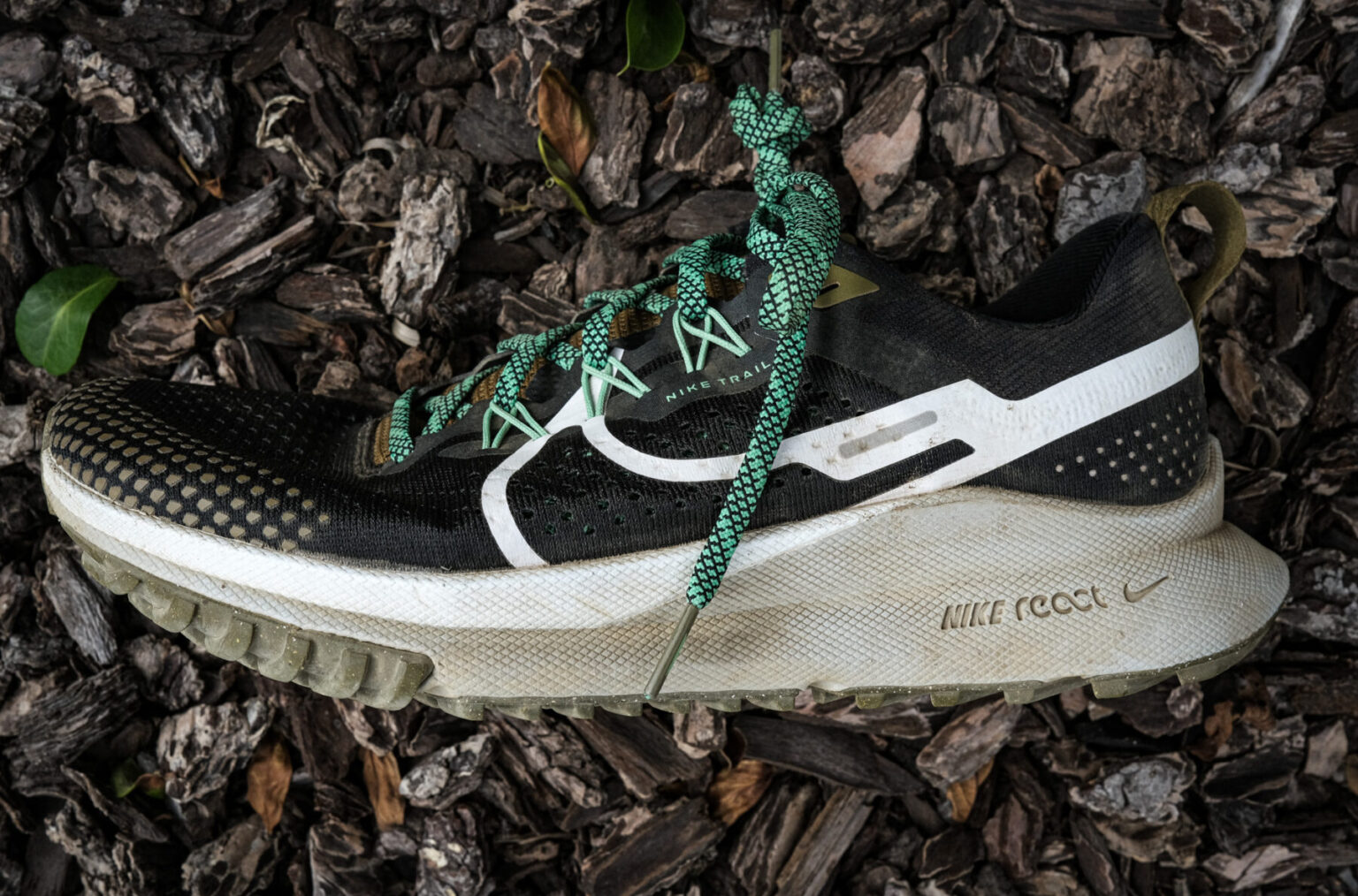Nike Pegasus Trail 4
Test Location: Marin, CA
Test Duration: 65 miles (so far)
Stated Stack Height (Men’s): 36 mm (heel) / 26 mm (forefoot)
Stated Heel-to-Toe Drop: 10 mm
Stated Features:
- A midsole made from “React” foam
- “Flywire” technology and a midfoot band for support
- Outsole uses a “generative traction pattern” for improved grip
- Gusseted tongue
- Drastically decreased weight from its previous iteration
Size Tested: US Men’s 8.5 / EU 42
Reviewer: 5’9”, 150 lbs / 175 cm, 68 kg
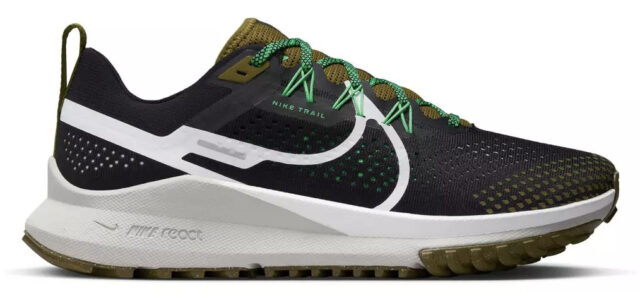
Stated Weight per Shoe (US Men’s Size 9): 289 g / 10.2 oz
Blister Measured Weight per Shoe (US Men’s Size 8.5):
- Shoes + Laces: 249 g (left) & 255 g (right)
- Insoles: 20 g (left) & 21 g (right)
- Total: 269 g (left) & 276 g (right)
MSRP: $140
Intro
The release of the largely redesigned Nike Pegasus Trail 4 appears to be an attempt to bring the shoe full circle, uniting new Nike technology and prevailing themes in the trail shoe industry with similar styling and sense of purpose owned by the original Pegasus Trail. After spending a few iterations experimenting with form, the latest model adopts a more conventional profile. I’ve logged a few runs in my pair over the last few days and liken the experience to driving a restomod, a classic car that has been restored and modified with modern parts. In this first look, I’ll go through the Pegasus Trail 4’s construction from upper to outsole, and then follow up with a full-length review in the near future.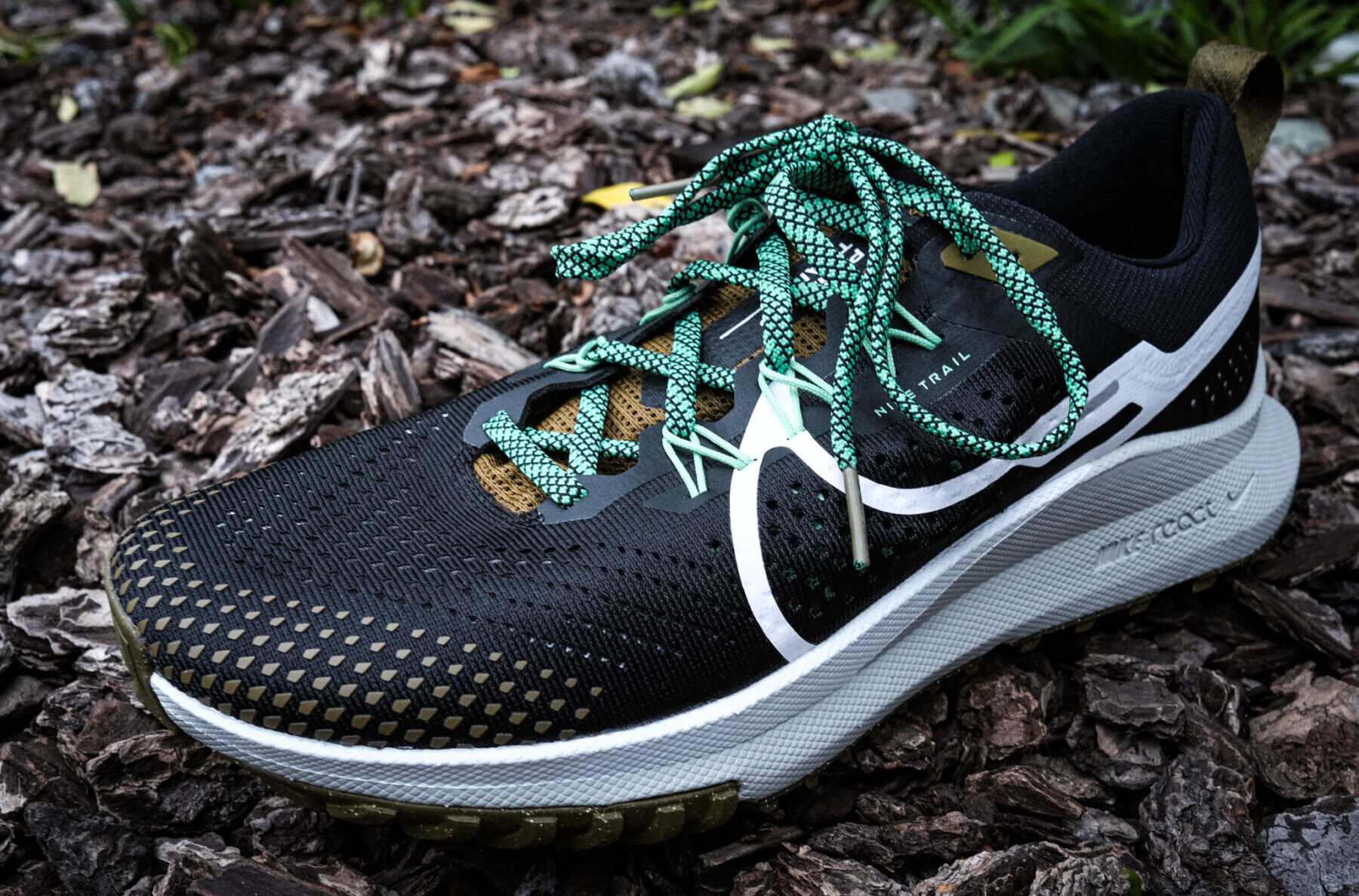
Fit & Features
As I’ve mentioned in previous reviews of Nike’s trail shoes, Nike has done a pretty solid job of acknowledging that models intended for off-road use need to fit differently than their fleet of dedicated road shoes. Similar to the Wildhorse 8, which I’ve been testing concurrently, the Pegasus Trail 4 is built on a broader platform than examples like the Nike Zoom Fly and Streakfly; the Pegasus Trail 4’s toe box is more squared off than both of those models and its width through the midfoot is comparatively generous.
Set beside the Wildhorse 8 though, and the Pegasus Trail 4’s road lineage comes into view. Its fit is much more precise from heel to toe, with a moderately tapered forefoot that holds its relative narrowness through the arch. But perhaps the most significant difference between the two is the Pegasus Trail 4’s additional heel-to-toe differential. With a 10 mm drop, the shoe shares the same measurement as the Pegasus 40. While that number is pretty commonplace for a road shoe, it’s extreme for most trail shoes. Brands will often use high drops as a substitute for a rockered geometry because both styles attempt to account for heel striking, and I imagine Nike is following that trend here. On foot, the Pegasus Trail 4’s built-up heel is the shoe’s dominant feature fit-wise, something that I could see helping its performance on road / runnable trail but harming how well it handles chunkier terrain.
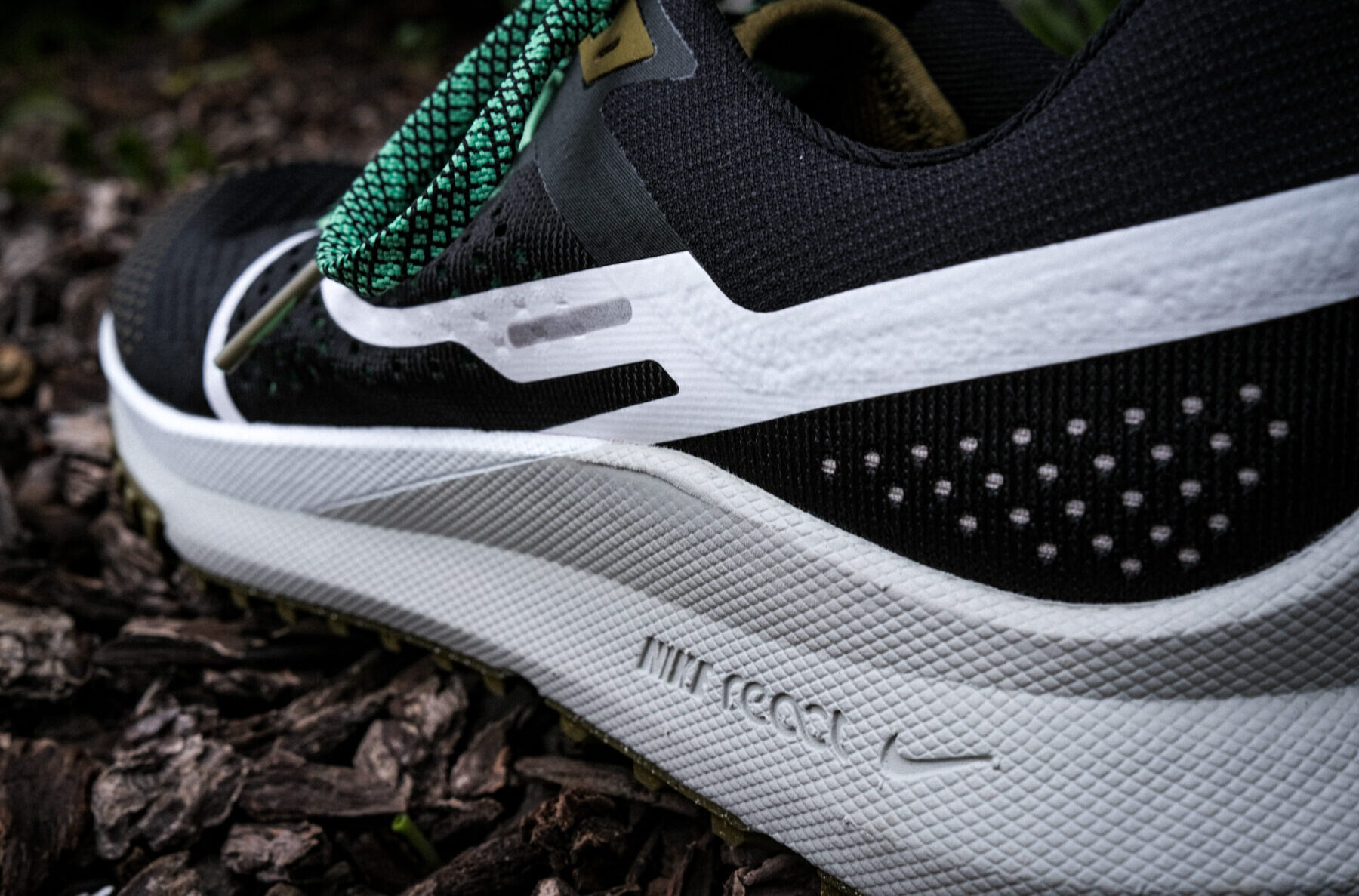
One of the primary criticisms of the Pegasus Trail 3 was its weight; at 321 g for a US Men’s size 9, it was one of the heaviest shoes in the maximal category. While a shoe’s weight arguably shrinks in importance as the distance it’s intended for increases, there is definitely a ceiling when weight’s concerned, and the Pegasus Trail 3 was pressed up against it. As such, most of the changes to the latest iteration involve trimming grams where possible, and the Pegasus Trail 4 will likely benefit from those efforts immensely. For context, here’s how the shoe’s stated weight compares to the stated weights for some other similar models, including the Pegasus Trail 3. All weights are based on a US Men’s Size 9.
252 g / 8.9 oz — Hoka Challenger 7
275 g / 9.7 oz — La Sportiva Jackal II
280 g / 9.8 oz — Salomon Pulsar Trail
280 g / 9.9 oz — Inov-8 Parkclaw G 280
280 g / 9.9 oz — On Cloudvista
286 g / 10.0 oz — Salomon Sense Ride 5
284 g / 10.0 oz — Topo Athletic Mtn Racer 2
289 g / 10.2 oz — Nike Pegasus Trail 4
289 g / 10.2 oz — Topo Athletic Ultraventure 3
290 g / 10.2 oz — La Sportiva Karacal
292 g / 10.3 oz — Hoka Speedgoat 5
297 g / 10.5 oz — Brooks Cascadia 16
321 g / 11.3 oz — Nike Pegasus Trail 3
32 g / 1.1 oz is no small amount to strip away from a shoe between iterations, and Nike plucks the majority of this excess weight from the Pegasus Trail 4’s upper. A new engineered mesh is used over the forefoot, and the previous version’s thick protective overlays have been swapped out for a speckled, snake-skin-like pattern of laminated dots. While ostensibly a pretty unstructured design, the shoe’s upper relies on Nike’s signature “Flywire” technology and a gusseted tongue to provide support through the arch. Flywire integrates seamlessly with the shoe’s midfoot band, together allowing for what I’d consider a pretty locked-in fit. Nike managed to preserve quite a bit of cushioning in this area as well, with an ankle / heel collar that’s amply padded and a tongue that feels protective against lace bite.

The Pegasus Trail 4’s midsole will both likely look and feel recognizable to folks who’ve run in past iterations of the model. Nike uses familiar “React” foam and gives the shoe an identical stack height of 36 mm / 26 mm. Though not as lightweight nor energetic as Nike’s “ZoomX” foam, React foam seems better suited to absorb pounding from longer efforts and, in my experience, holds up better over time. The amount of it that Nike uses should help protect against how punishing running on firmer surfaces like concrete can be, as well as extend the Pegasus Trail 4’s range well into ultra-distances (i.e., 50ks and up).
In response to much clamoring, Nike finally addressed the underperformance of the Pegasus Trail’s outsole. Versions 2 and 3 of the shoe featured mealy rubber and confusing lug layouts incompatible with most trail conditions, not to mention pretty sluggish on the road. After going back to the drawing board, Nike updated the Pegasus Trail 4’s outsole in ways that not only will likely improve its traction but will also save weight while doing so. 4 mm lugs are concentrated in high-use areas under the forefoot and perimeter of the heel interspersed with cutouts that should help the shoe retain some of its flexibility / ground feel. While I’ve yet to really test out how tacky Nike’s new rubber is, to the touch it feels commensurate with some of the compounds La Sportiva uses, specifically “FriXion Red.” As I continue to log more miles in the Pegasus Trail 4, I’ll be focused on discovering its limits as a dedicated off-road shoe.
Some Questions / Things We’re Curious About
- 10 mm of heel-to-toe drop is, well, a lot for a trail shoe. How will this offset affect the Pegasus Trail 4’s performance on road and trail, respectively?
- Nike finally updated the Pegasus Trail’s stale and dysfunctional outsole construction. Will this new version improve the shoe’s stability on unpaved surfaces?
- Substantively, there’s not a lot going on protection-wise on the Pegasus Trail 4’s upper. How will this vulnerability affect performance / durability?
Bottom Line (For Now)
In several respects, the Pegasus Trail 4 feels like Nike is bringing one of their most popular off-road models full circle. Updates introduce new technology to a shoe that’s reverted to its original identity as a fairly lightweight road-to-trail hybrid after spending a few iterations masquerading as a burly ultra-distance option. To what degree scaling back the Pegasus Trail 4’s design does to its on-trail performance will be the focus of my forthcoming full review.
FULL REVIEW
Intro
Similar to the Nike Wildhorse 8, the Nike Pegasus Trail 4 has struggled to settle into an identity of its own through its first four iterations. The original version of the shoe clung to its source, the venerable Nike Pegasus, presenting itself as a trail-capable version of the brand’s longest-tenured road model. However, the Nike Pegasus Trail 2 and 3 were repositioned (and reinvented) as ultra-distance options, with increased stack heights, scale-tipping weights, and much more aggressive outsoles. As Nike has since expanded their trail line to include new maximal models, like the Zegama, and made tweaks to pre-existing long-distance shoes, like the recently updated Wildhorse 8, the Pegasus Trail line began to feel redundant in a lot of ways.
Fit
As Nike’s trail line has matured, it’s continued to distinguish itself from the brand’s seemingly limitless selection of road shoes. One of the most felt effects of this bifurcation has been the way most Nike trail shoes fit. Models intended for off-road use are under different constraints than their road counterparts, generally requiring higher volumes and wider lasts. Nike’s early attempts at trail shoes were frequently criticized for being too narrow, likely a byproduct of the footwear manufacturing process at the time (i.e., I suspect Nike used the same if not similar last for the Pegasus 36 and the Pegasus 36 Trail). Within the last few years, I’ve noticed a concentrated effort from Nike to shed this reputation, and the Pegasus Trail 4’s fit benefits from it.
Though not nearly as broad as the Nike Wildhorse 8, the Pegasus Trail 4’s platform is still much more spacious than any Nike road shoe I’ve worn. There’s adequate room for toe splay up front, thanks to the shoe’s rounded toe box, and there’s less of a severe taper from midfoot to forefoot; however, the Pegasus Trail 4 isn’t left lacking in arch support by any means. Like the Wildhorse 8, it benefits structurally from a wide, plush, gusseted tongue that comprehensively wraps the foot, providing great lockdown when laced tightly (which I was actually able to do comfortably, due to the tongue’s padding). Paired with Nike’s “Flywire Technology,” which consists of lightweight Vectran cables that function in place of supportive overlays across the midfoot, this system felt secure but not overbearing. In the rear, the shoe’s heel collar converges into a lightly padded cradle that’s uncomplicated and effective. So far, I have yet to experience any heel slippage or friction despite pushing the Pegasus Trail 4 on some pretty steep terrain.
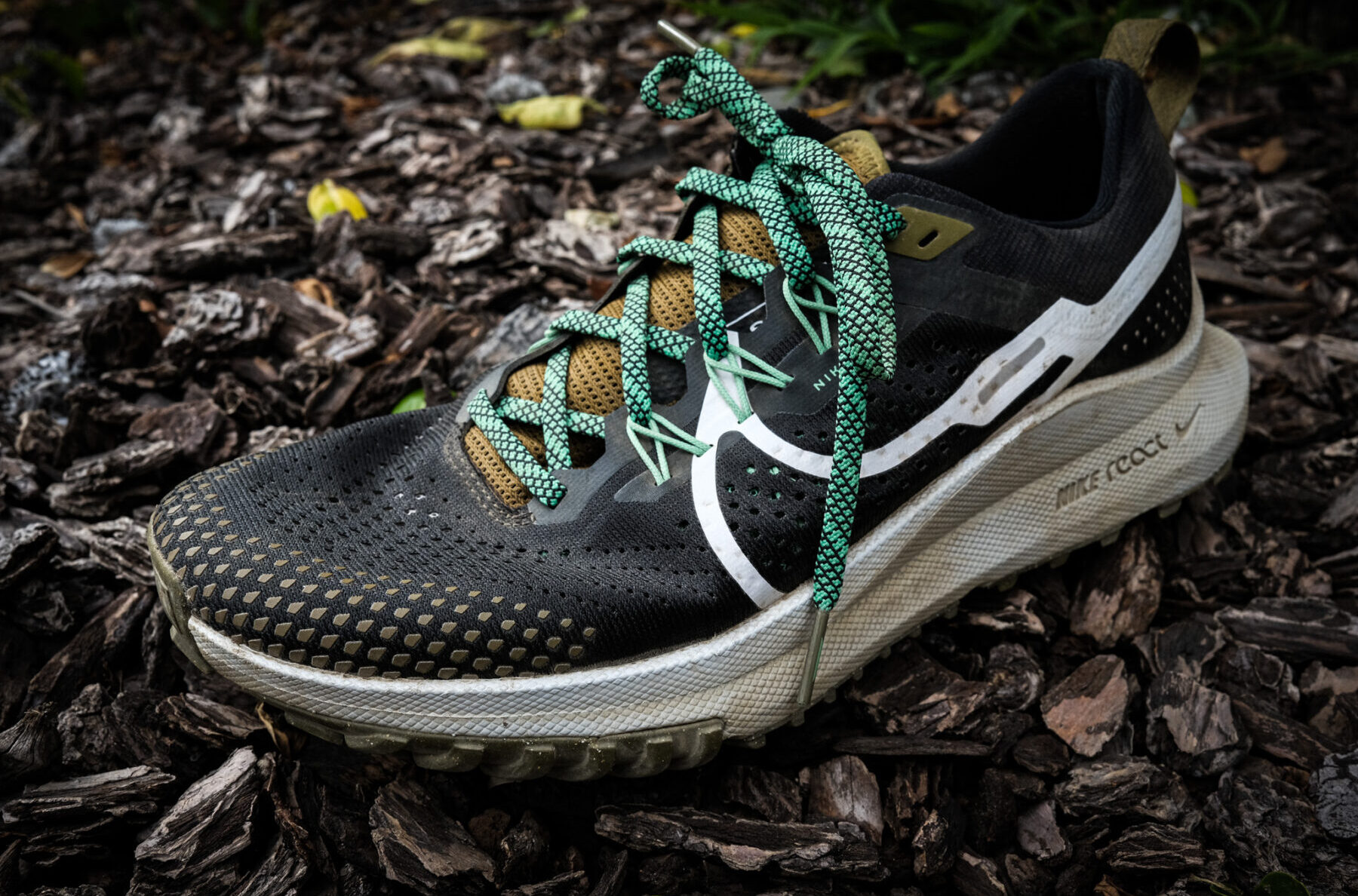
But perhaps the single most consequential feature affecting the Pegasus Trail 4’s fit is its heel-to-toe differential. With a 10 mm drop, the shoe shares the same measurement as the Pegasus 40. While that number is pretty commonplace for a road shoe, it’s extreme for most trail shoes. Brands will often use high drops as a substitute for a rockered sole geometry because both styles attempt to account for heel striking, and I imagine Nike is following that trend here. As someone with more of a forefoot strike, the Pegasus Trail 4’s built-up heel dictated my running mechanics, forcing me further onto my toes. While I didn’t necessarily mind this, it did make the shoe feel far less cushioned than its 36 mm / 26 mm stack height suggests. I should also note that, like the Wildhorse 8, the Pegasus Trail 4 runs (encouragingly) true to size. Hopefully, this is a sign that Nike has made some effort to standardize their sizing. I know that their inconsistency has been a huge source of frustration for me and others in the past.
Weight
One of the primary criticisms of the Pegasus Trail 3 was its weight; at 321 g for a US Men’s size 9, it was one of the heaviest shoes in the maximal category. While a shoe’s weight arguably shrinks in importance as the distance it’s intended for increases, there is definitely a ceiling when weight’s concerned, and the Pegasus Trail 3 was pressed up against it. As such, most of the changes to the latest iteration involve trimming grams where possible, and the Pegasus Trail 4 benefits from those efforts. For context, here’s how the shoe’s stated weight compares to the stated weights for some other similar models, including the Pegasus Trail 3. All weights are based on a US Men’s Size 9.
252 g / 8.9 oz — Hoka Challenger 7
275 g / 9.7 oz — La Sportiva Jackal II
280 g / 9.8 oz — Salomon Pulsar Trail
280 g / 9.9 oz — Inov-8 Parkclaw G 280
280 g / 9.9 oz — On Cloudvista
286 g / 10.0 oz — Salomon Sense Ride 5
284 g / 10.0 oz — Topo Athletic Mtn Racer 2
289 g / 10.2 oz — Nike Pegasus Trail 4
289 g / 10.2 oz — Topo Athletic Ultraventure 3
290 g / 10.2 oz — La Sportiva Karacal
292 g / 10.3 oz — Hoka Speedgoat 5
297 g / 10.5 oz — Brooks Cascadia 16
321 g / 11.3 oz — Nike Pegasus Trail 3
32 g / 1.1 oz is no small amount to strip away from a shoe between iterations, and Nike plucks the majority of this excess weight from the Pegasus Trail 4’s upper. A new engineered mesh is used over the forefoot, and the previous version’s thick protective overlays have been swapped out for a speckled, snake-skin-like pattern of laminated dots. Unlike the Wildhorse 8, which at times felt bottom heavy due to its thick rubber outsole, the Pegasus Trail 4 is constructed in a way that better distributes its mass. While still likely not light enough to be used as an option for short races / workouts, its weight won’t be the limiting factor that excludes it from an otherwise wide spectrum of uses. I’ve worn the shoe for long runs and hill intervals alike without feeling like I had to expend extra effort to pick up my feet in either context.
Upper
I applaud Nike for giving shoe tongues the attention they deserve. Where other brands try to get away with less, they have taken advantage of what some consider to be an “off cut” part of the upper and made it into a critical feature. Much like the Wildhorse 8’s broad, gusseted tongue, which I called that shoe’s “beating heart,” the Pegasus Trail 4’s is given a similar treatment. It’s slightly narrower and a bit lighter, but is equally as cushioned and supportive. Laces that overlap across the tongue are moored by Nike Flywire, a web of cables that run laterally and medially along the midfoot to help provide additional stability (much like overlays, though lighter, and in my opinion more effective).
Elsewhere, the Pegasus Trail 4’s upper keeps things pretty simple. It shares the same 2-layer system Nike uses for the Wildhorse 8, to draw yet another comparison between the two models. A thin internal liner made from stretch fabric is partnered with a thicker outer layer made from flexible engineered mesh. I’ve shaken my fist at this design before, favoring single-layer uppers made from premium materials instead, but the Pegasus Trail 4’s upper hasn’t given me any reason to gripe about it yet. If anything upsets me, it’ll likely be the shoe’s lack of protection. Instead of providing the Pegasus Trail 4 with a serious toe rand, Nike makes a half-gesture in the form of hardened “scales” in the silhouette of one. Aesthetically, they serve as a reminder that the shoe is still very much a hybrid between a road and trail model. Practically, they don’t accomplish much.
Aside from that minor nitpick, I do think that the Pegasus Trail 4’s reinvented upper is successful. It never felt fussy, stuffy, nor preoccupied with trying to do too much. This banality extends to the shoe’s ankle / heel collar as well. Both are cushioned enough to enhance fit, and the semi-rigid heel counter is rudder-like in its stability and just the right height (i.e., not too tall) for a shoe with a 10 mm drop. There’s a lot to be gained from the expression, “keep it simple, stupid,” and I think that notion registers across Nike’s entire trail line these days.
Midsole
The Pegasus Trail 4’s midsole is one of the shoe’s only features that’s carried over from its previous iteration, and that’s a huge positive. Nike uses familiar “React” foam and gives the shoe an identical stack height of 36 mm / 26 mm. Though not as lightweight nor energetic as Nike’s “ZoomX” foam, React foam seems better suited to absorb pounding from longer efforts and, in my experience, holds up better over time. Set between a lighter upper and trimmed-down outsole, the Pegasus Trail 4’s midsole feels like a completely new addition to the shoe. Its softness cushions well, provides high amounts of ground feel, and allows the shoe to flex in response to foot strike. These attributes also play key roles in stabilizing the foot on off-camber terrain, which I think potentially offset some of the tippy-ness inherent in shoes with tall stack heights and narrow-to-average platforms.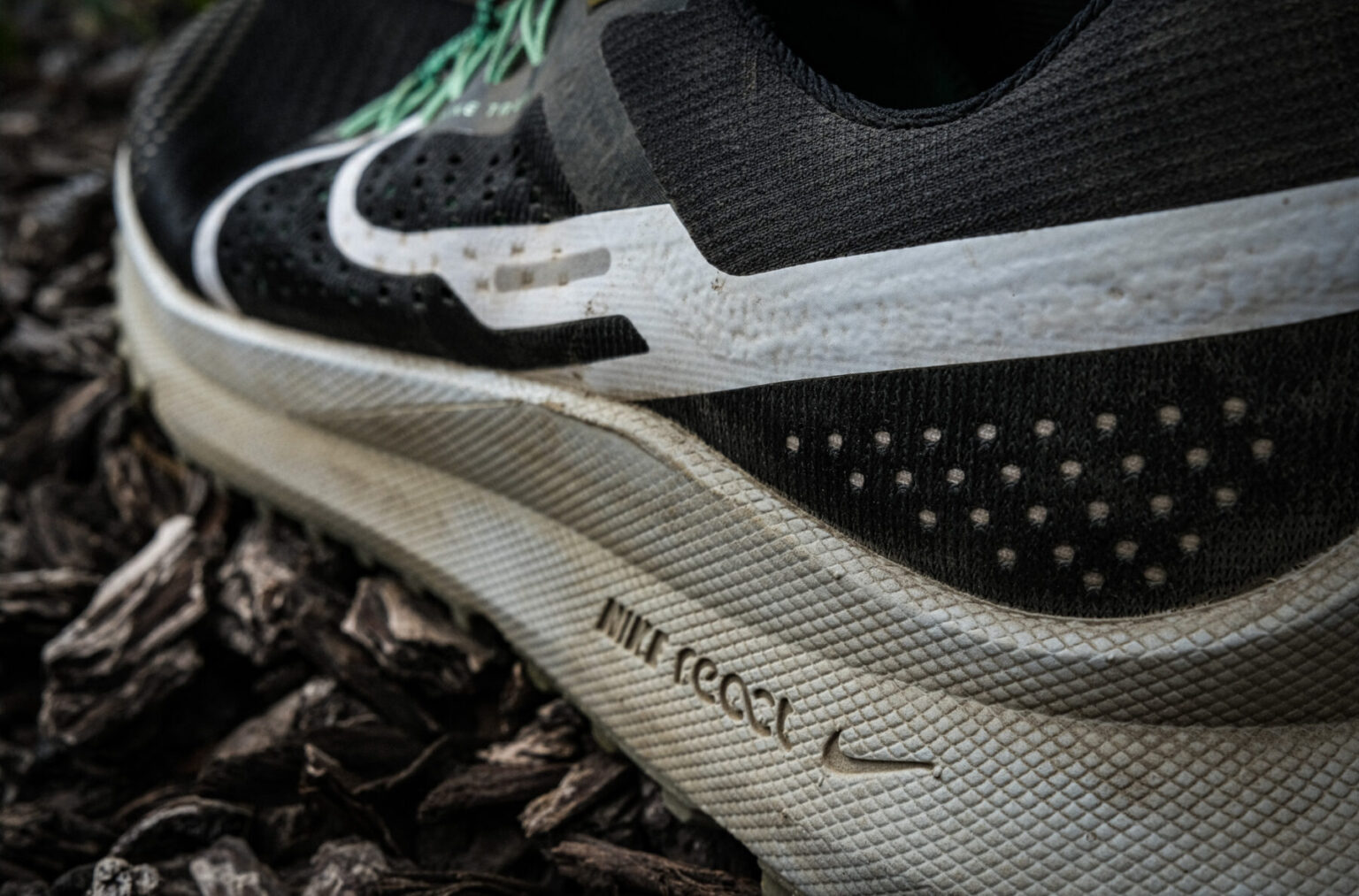
Outsole
Past iterations of the Pegasus Trail have really struggled to find a winning outsole design. I’m not the first to be critical of the mealy rubber Nike has used, or the nonsensical way they laid out the shoe’s lugs, but hopefully I’m one of the last. After going back to the drawing board, Nike updated the Pegasus Trail 4’s outsole in ways that not only will likely improve its traction but will also save weight while doing so. 4 mm lugs are concentrated in high-use areas under the forefoot and perimeter of the heel, and are interspersed with cutouts that help the shoe retain some of its flexibility / ground feel.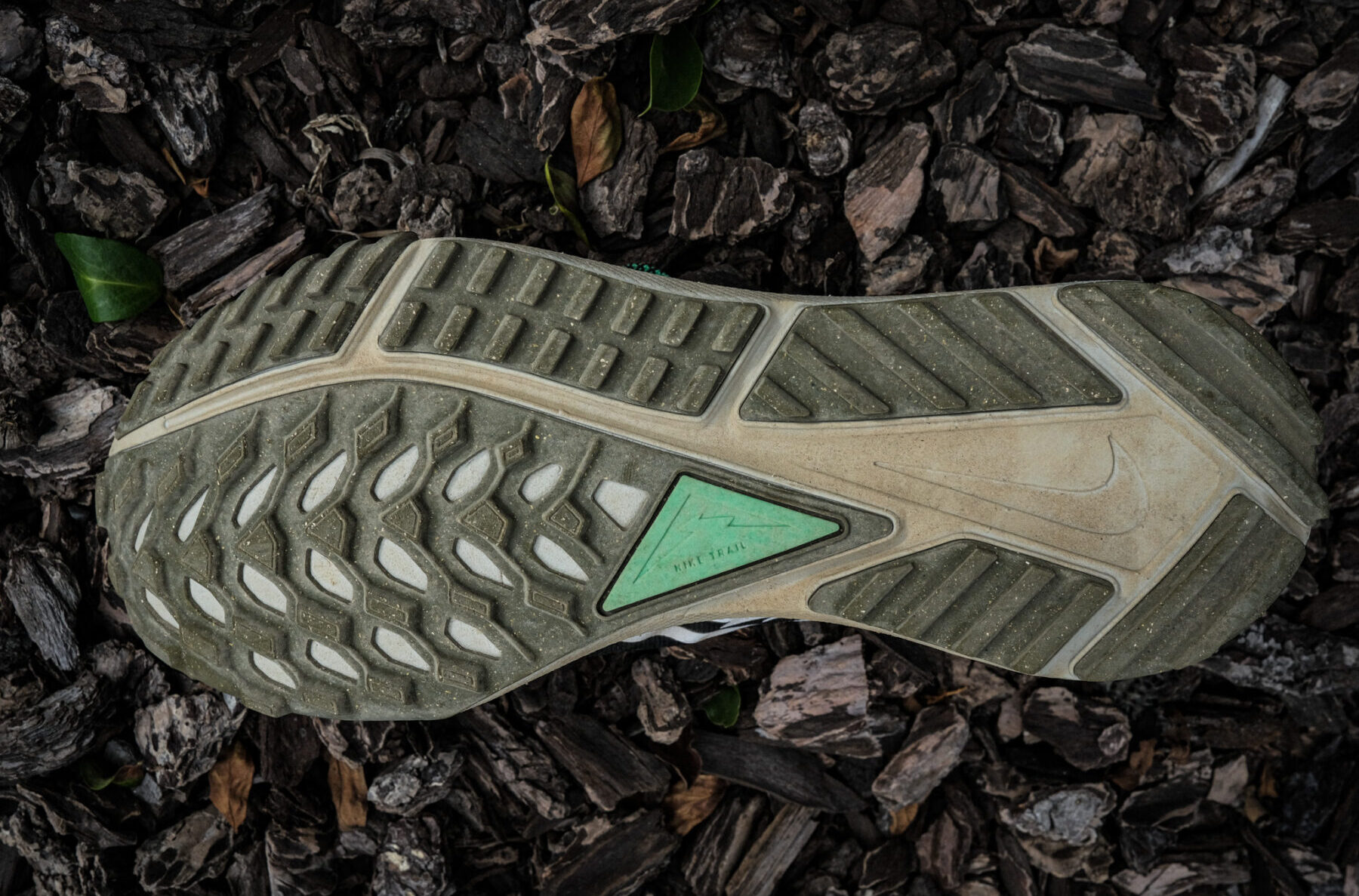
On Trail
I’ve settled into a nice routine of putting basically every trail shoe I review through a pretty similar testing process. In most cases, that takes the form of 6 days of running a week with one workout (usually some type of hill interval), a collection of social runs, and a lengthier effort between 3 and 5 hours. However, because the Pegasus Trail 4 is technically considered a hybrid model, a shoe meant for hopping back and forth between tarmac and dirt, I swapped out my normal long run in Marin for an urban trail outing in San Francisco.
As I covered in my conversation with filmmaker Ryan Scura for Off The Couch, The City has dozens of miles of both steep and flowy singletrack interspersed with sections of road that can be linked up pretty easily. While I prefer to run exclusively on trails most of the time, the Pegasus Trail 4 made pounding up and down sidewalks a more pleasant experience. The shoe’s high amount of cushion spared my joints, its steep heel-to-toe drop felt like it made my stride more efficient, and the reduction in weight compared to the previous model kept me from feeling like I was completely “over-shoed” (a play on the term “over-biked”) for road running.
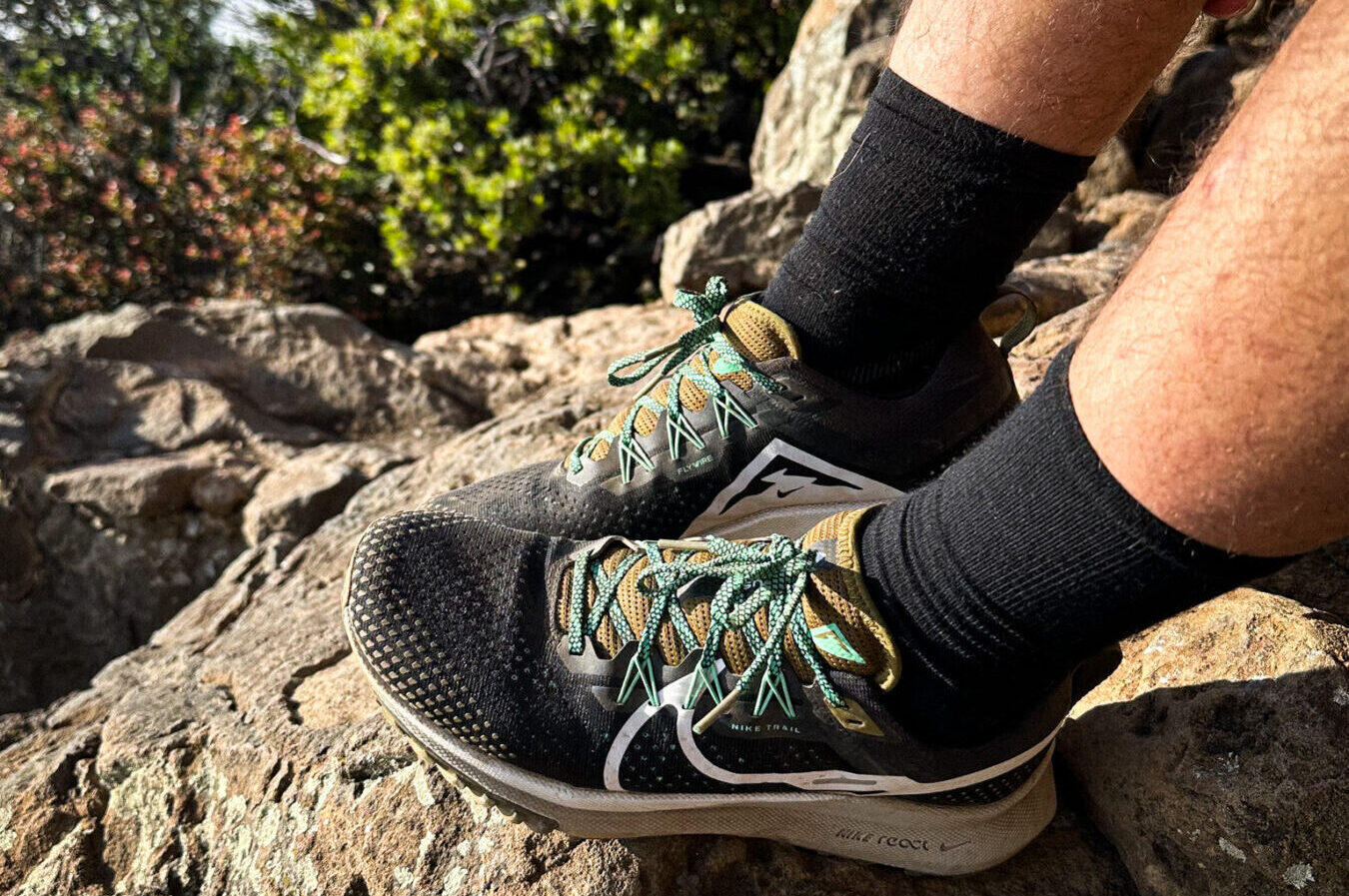
The Pegasus Trail 4 really felt like it came alive once plopped on dirt though, revealing a bias toward trails that I was more than happy to indulge. As I’ve said, the Pegasus Trail 4’s plush React foam is a far cry from the pop of Nike’s ZoomX foam, but the shoe’s overall flexibility and road-forward geometry (i.e., 10 mm of drop) prevented the React midsole from coming across as sluggish. In fact, I sometimes think ZoomX foam can be too chaotic / unpredictable when stressed at fast paces, so I ended up quite liking the controlled, settled energy return React foam delivered when I decided to crank up the effort. No doubt this was also aided by the excellent gusseted tongue / Flywire Technology combo that contributed to the shoe’s secure yet accommodating fit. Cornering felt natural and managed, and my foot stayed engaged and steady while climbing / descending.
I’ve often thought that all road-to-trail models need to compromise somewhere. I still think that’s mostly true, but the Pegasus Trail 4 has at least made me question how ardently I actually believe that anymore. Aside from lacking a little bit of protection for burly rock gardens that I seldom pass through anyway, I couldn’t find too many flaws in the shoe when used exclusively for trails. As a dedicated road shoe on the other hand, the only thing I felt like I would have altered about the Pegasus Trail 4 is, predictably, its weight. Shaving 10 to 15 grams by reducing a few trail-specific features would be easy to do. Otherwise, its cushion and geometry are things I look for when shopping for road options to begin with. For these reasons, I’m excited to consolidate my shoe quiver a little bit by replacing a pair or two of less capable road / trail models I have laying around with the Pegasus Trail 4, taking confidence in knowing that it’ll be able to handle the workload of both.
Durability
Admittedly, 65 miles is kind of at the lower end of what I like to put on a shoe before reviewing it. Still, I think I can submit some informed opinions on the Pegasus Trail 4’s durability moving forward. As they exist now, my pair has shown little to no wear aside from some general stretching in the upper. The midsole foam’s energy return hasn’t shifted since breaking in, and the abrasion-resistant outsole rubber has lived up to its name (which is noteworthy, considering how many road miles I’ve asked it to survive).

Who’s It For?
The Pegasus Trail’s return to a venerable road-to-trail option undoubtedly opens it up to a wider body of runners. As an option that will likely find success in just about any scenario, it probably makes the most sense for trail runners living in urban areas who enjoy piecing together sections of singletrack from their door. That said, the Pegasus Trail 4 shouldn’t be discounted as a dedicated long-distance trail shoe either; I see no reason why its range shouldn’t be able to extend upwards of 50 miles at a time, just as long as the route doesn’t get too technical and your preferences align with the rest of the shoe’s design.
Fit-wise, Nike has put a lot of effort into making their trail shoes more compatible with a wider spectrum of feet, particularly wide ones, so unless you’re on the extreme of that spectrum, the Pegasus Trail 4 should have plenty of room for most foot shapes. The shoe’s smartly thought-out upper should also allow many folks with narrow feet to arrive at the security / lockdown they need. I’d also add that models with high heel-to-toe drops have been recommended to runners struggling with Achilles issues, so if you find yourself in that population, the Pegasus Trail 4 could help offload some stress on that tendon. Conversely, if you’ve gravitated toward shoes with little to no heel-to-toe drop in the past, it’ll likely require at least a bit of an adjustment, if not a significant one.
Bottom Line
In several respects, the Pegasus Trail 4 feels like Nike is bringing one of their most popular off-road models full circle. Updates introduce new technology to a shoe that’s reverted to its original identity as a fairly lightweight road-to-trail hybrid after spending a few iterations masquerading as a burly ultra-distance option. While the shoe’s high heel-to-toe drop could not mix well with some folks’ preferred running styles, if you’re looking for a comfort-forward hybrid model that can flip the switch quickly between road and less-technical trail, I couldn’t recommend the Pegasus Trail 4 more.

